#gyponana
Explore tagged Tumblr posts
Text










Gyponana Leafhopper - Gyponana sp.
I was hopeful when taking this leafy-green insect's picture that identification would be simple and straightforward. In practice, identification down to the specie has proven difficult, but at least the genus was achievable. Many Leafhoppers are similar in appearance, so it takes a keen eye and a close examination of the Hopper's details to be certain, up to the point of collection. In particular, the underside, and I'm not talking about the spines used for sensory purposes. I've only learned this after the fact, but nevertheless I'll be leaving these insects to hop around their plants in peace. Despite this individual's best efforts to blend into the foliage it walks on, these insects can be (initially) surprisingly easy to find. This is because they'll hop away if they sense danger.
After that hop away, if your eyes haven't tracked them they will disappear among the greenery. With a large size and the prominent cells along the wings (quite visible whether in light or shadow), one could be forgiven to mistaken them for a small leaf, akin to their distant Planthopper cousins. The stripes along the pronotum are quite pretty to look at while the Bug can remain still, but what really impresses me is the antennae. Other species showcased earlier have small antennae, up to the point of being hardly visible. Meanwhile, the antennae here are quite visible even without zooming in a photograph. They are quite long and thin, more so proportionally compared to other larger Hemipterans like Cicadas. I've thought that the antennae's thinness may be a compromise to allow for less interference during hopping, while also allowing great sensory of a surrounding environment. Perhaps comparing this individual against other finds may provide some insight.
Pictures were taken on July 7, 2024 with a Google Pixel 4.
#jonny’s insect catalogue#ontario insect#leafhopper#gyponana leafhopper#green leafhopper#gyponana#true bug#hemiptera#auchenorrhyncha#insect#hopper#july2024#2024#toronto#nature#entomology#invertebrates#arthropods#photography#animals
36 notes
·
View notes
Text
I see at least one cool bug a day, and usually many more, but it’s not because I live anywhere particularly rich in strange, wonderful creatures (I live in an unremarkable corner of Pennsylvania, USA) or spend all of my free time looking for bugs (well, just *most* of it). in my experience, finding interesting bugs is less about actually locating them and more about looking closely at tiny things you’d otherwise ignore!
this very long post was compiled over a couple days in late July, although I spent less than 10 minutes at a time searching. there’s a lot of fun creatures just out in the open.
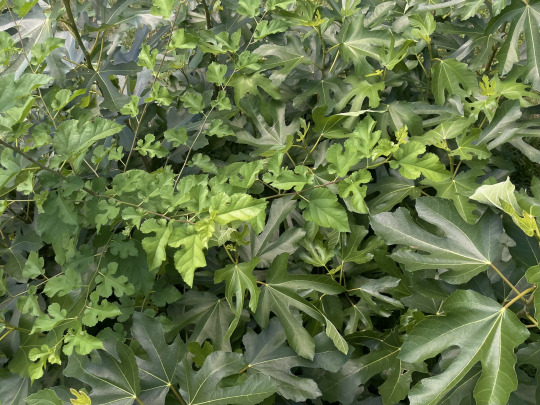
plants are always a good place to start when looking for bugs, and I chose this small fig tree (Ficus carica) with a mulberry sapling friend. feeding on the sap of the fig and mulberry is the first group I’ll take a look at, the planthoppers:

these two are flatid bugs, Metcalfa pruinosa and Flatormenis proxima. flatids are slow-moving bugs that can be approached closely, but once they get tired of circling around stems to avoid you they may launch themselves into a fluttering flight with spring-loaded rear legs.
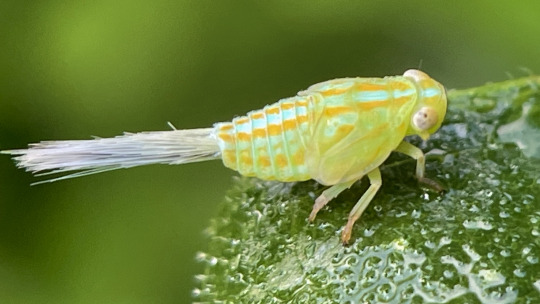
Aplos simplex, a member of the related family Issidae, also likes fig sap. its “tail” is actually a tuft of waxy secretions, which get shed along with the bright colors when it assumes a lumpy, bean-shaped adult form.
cicadellids, or leafhoppers, are just about everywhere on plants, but can be hard to approach without scaring them.
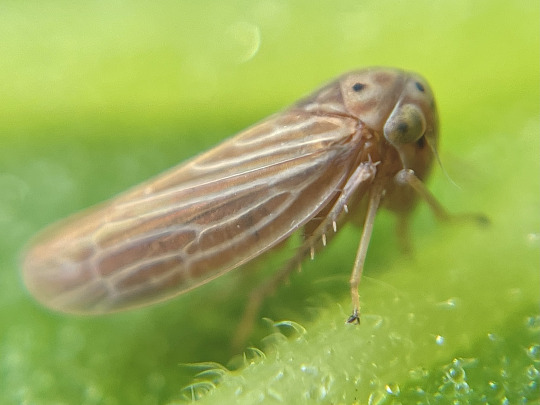
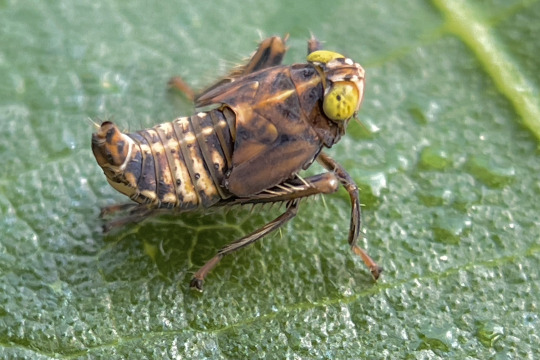
Agallia constricta on the left is a tiny species that feeds on grass, but many were scared up onto the fig by my footsteps. Jikradia olitoria is a much larger species that does feed on the fig; juveniles like this are curled, creeping goblins while adults’ rounded wings give them a pill-shaped appearance.

this big, pale leafhopper belongs to genus Gyponana. it’s tricky to get to species ID with these.
Graphocephala are striking little hoppers that eat a variety of native and nonnative plants. G. coccinea is the larger, more boldly colored one and G. versuta is smaller but more common locally. they’ll sit on the tops of leaves but take flight if you get too close quickly.

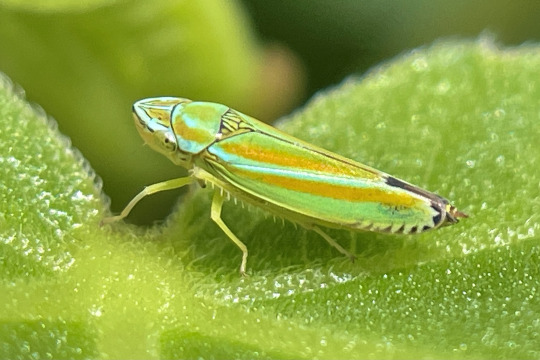
another group you’re almost guaranteed to encounter are flies (Diptera). these are a very diverse group, so much more than houseflies and mosquitoes (though I did run into both)
where I live, any plant with broad leaves is almost guaranteed to have a few Condylostylus, long-legged flies that come in shades of blue, green, and red. despite their dainty physique, they’re agile predators, typically feeding on other small flies.
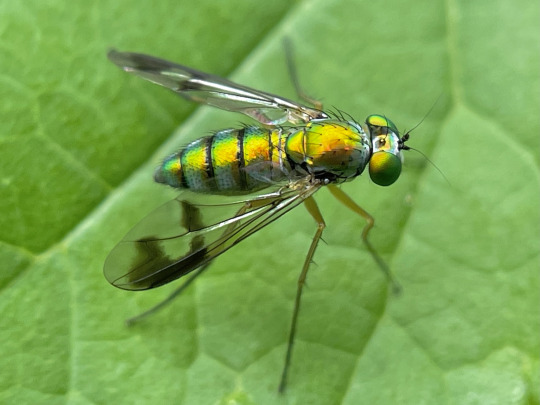
next, a few hoverflies: the ubiquitous Toxomerus geminatus and a Eumerus that I’ve been seeing a lot of this year (but maybe I’ve just noticed them for the first time). syrphids have varied life histories, but most adults drink nectar and many of the larvae are predaceous on aphids.
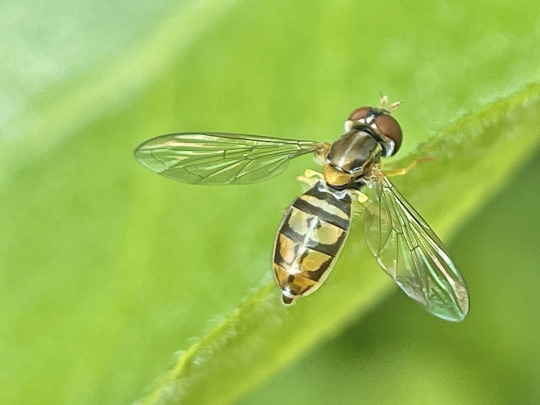
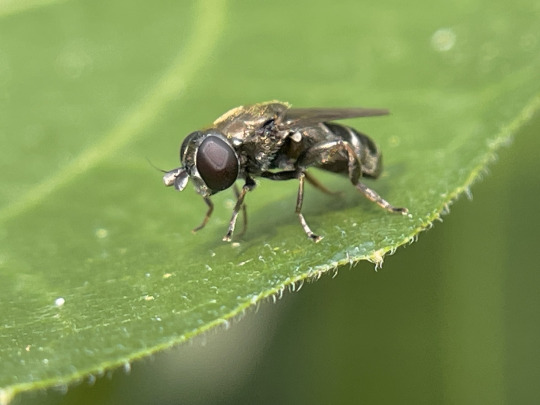
the metallic green soldier fly is Microchrysa flaviventris, nonnative here. Coenosia is a fun example of a “fly that looks like a fly,” with big red eyes and a gray body, and you might think they’re just another dung-sucking pest, but they’re actually aggressive predators! this one seemed to have nabbed itself some sort of nematoceran fly, maybe a fungus gnat.
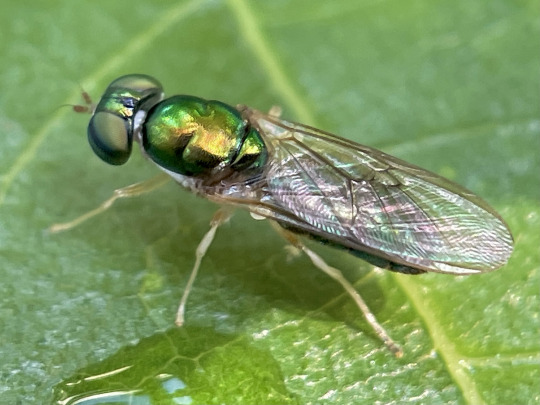
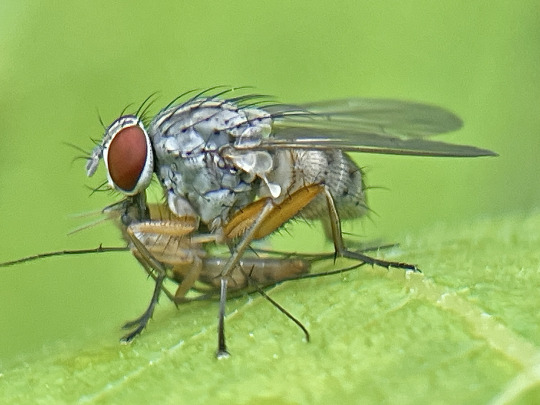
many flies are very tiny, just millimeters long. the first two little fellows are lauxaniids, while the last one, an agromyzid leafminer Cerodontha dorsalis, burrows through grass leaves as a larva.
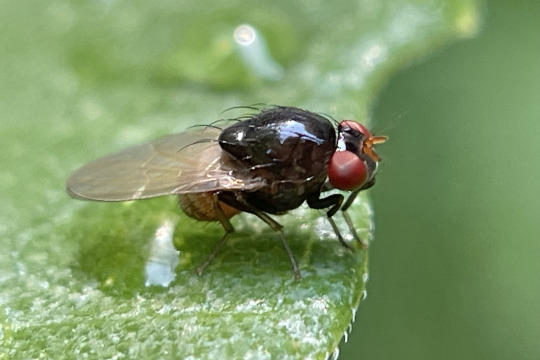
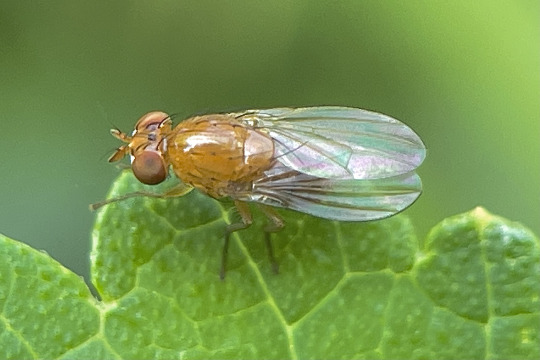
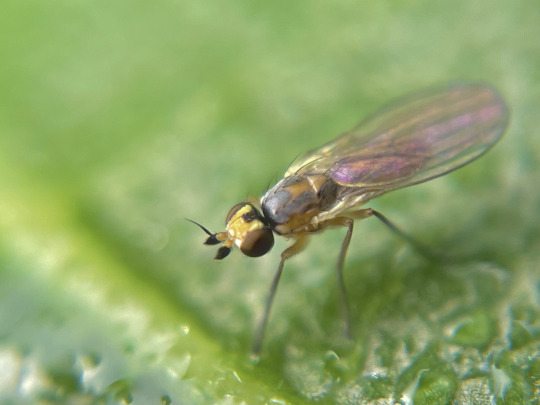
while moths and butterflies (Lepidoptera) are drawn to plants for their flowers or to lay eggs, many small moths can easily be found resting on or under leaves during the day.
these first two are tortricids, many of which are flat, rectangular moths resembling chips of bark or dead leaves. the apple bud moth, Platynota idaeusalis, feeds on a wide variety of hosts, while this beat-up old Argyrotaenia pinatubana would have developed in an edible tube nest of pine needles.

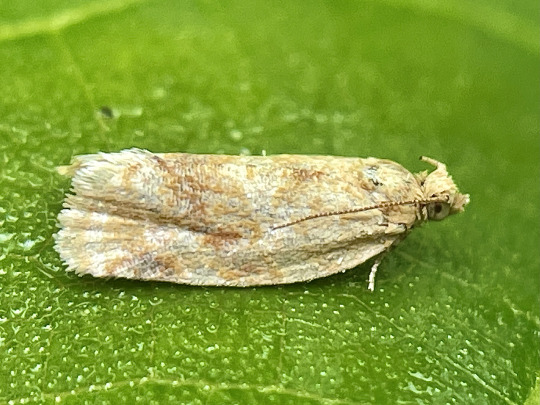
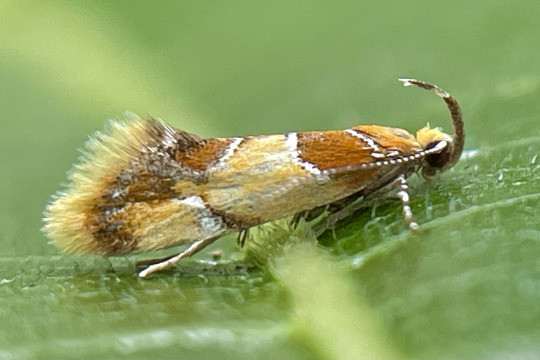

Callima argenticinctella feeds in bark and dead wood (a resource used by more caterpillars than you’d realize!) while the last moth, possibly an Aspilanta, is a leafminer.
although beetles (Coleoptera) are famous for their diversity, I didn’t find too many on the fig. the invasive Oriental beetle Exomala orientalis resting here can be found in a wide range of colors, from this common tan to to deep iridescent black. the other beetle is a Photinus pyralis firefly, sleeping under leaves as fireflies do.
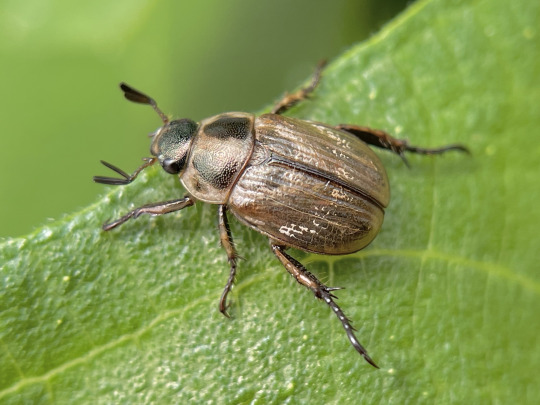
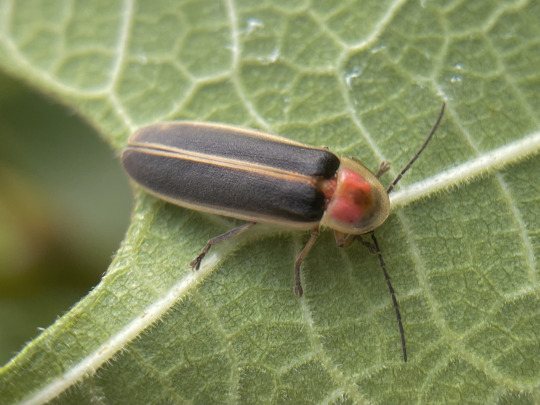
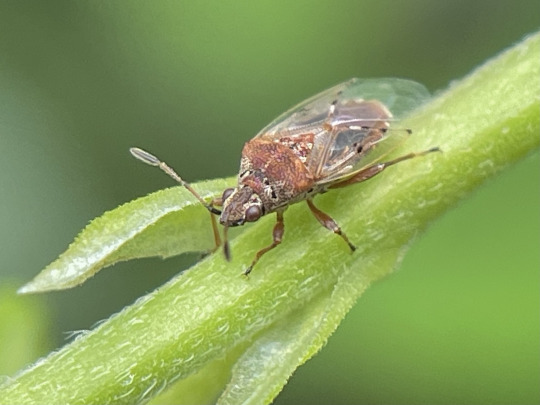
a few spare hemipterans: a Kleidocerys resedae that blew in on a wind, and below, the mulberry whitefly Tetraleurodes mori feeds on its namesake host. as for Hymenoptera, I saw manny tiny parasitic braconid wasps and various ants attracted to the planthoppers’ honeydew excretions—always worth checking underneath roosting hoppers for things having a drink.

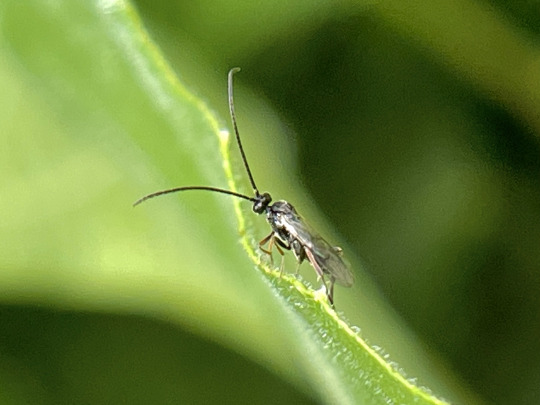
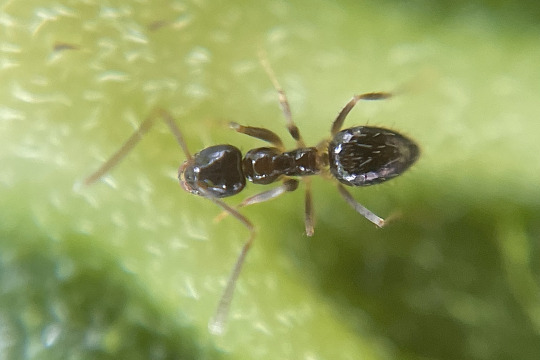
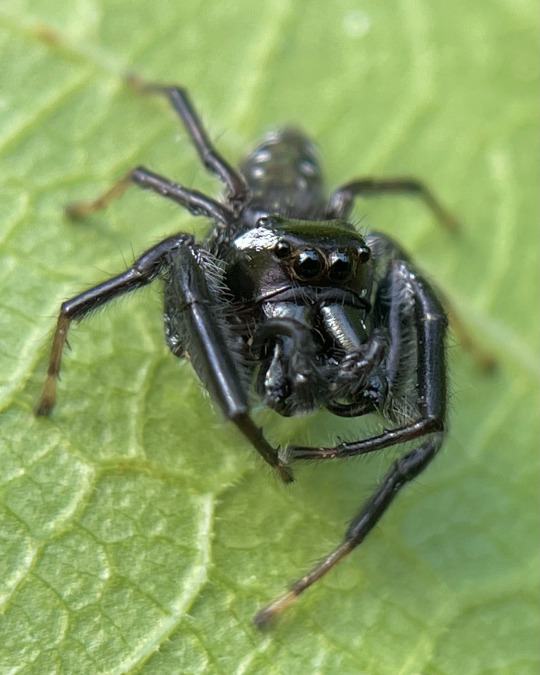
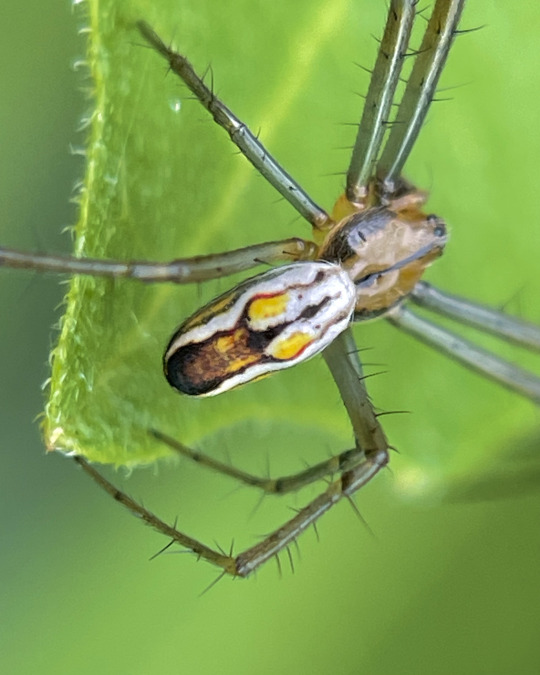
a couple handsome spider boys were scrambling through the fig seeking females, a jumping spider Paraphidippus aurantius and an orbweaver, Mecynogea lemniscata.
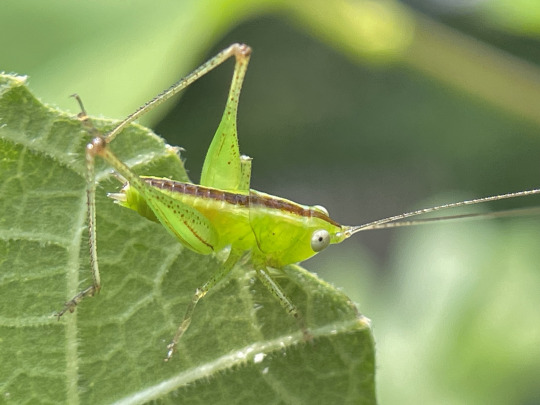
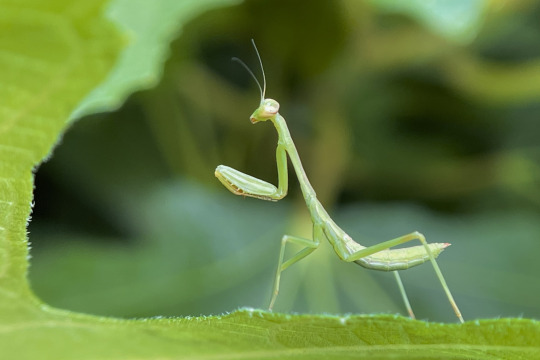
and to round it off, a young Conocephalus meadow katydid and a Carolina mantis, Stagmomantis carolina.
there’s 31 species of arthropod in this post, and I probably saw some 45, not all of which stayed for photos. if you walk slowly and look closely, you can see a sizeable chunk of your local biodiversity in under fifteen minutes! of course this will depend on where you live and what time of year it is, but there’s almost always more cool bugs out there than you’d expect, even on just a single plant.
1K notes
·
View notes
Note
Found this little guy while trimming some herbs, any idea what it is? Upstate NY if that helps.


Planthopper ID - NY, USA:
Hello, yes, I'm pretty sure that this is the nymph (it doesnt have wings) of a planthopper (probably Cicadellidae), but there aren't great resources for identifying these.
Some ideas are Fieberiella sp., Xerophloea sp., Gyponana sp.
Any ento people on here have another idea?
@onenicebugperday
127 notes
·
View notes
Text




a stunning Gyponana gladia leafhopper
7 notes
·
View notes
Text
Pourquoi les cicadelles réfléchissent-elles peu la lumière ? | Pour la Science
See on Scoop.it - EntomoNews
Le corps de ces petits insectes est recouvert de structures nanoscopiques, des brochosomes. On s’attendrait à ce qu’ils augmentent la réflexion de la lumière, mais ils ont l’effet inverse. Ce paradoxe vient d’être compris.
Biophysique
Charlotte Mauger
26 avril 2024| POUR LA SCIENCE N° 559
Geometric design of antireflective leafhopper brochosomes | PNAS, 18.03.2024 https://www.pnas.org/doi/10.1073/pnas.2312700121
[Image] Leafhopper and its brochosomes. (A) An optical image of a leafhopper Gyponana serpenta. (B) A scanning electron microscopy (SEM) image of the leafhopper wing (highlighted area in panel A). (C and D) SEM images of brochosomes on the leafhopper wing, revealing their hollow buckyball-like geometry. (E) An SEM image showing the cross-section of a natural brochosome cleaved by the focused ion beam (FIB) technique. (F) The relationship between the diameter of brochosome through-holes and the diameter of brochosomes across different leafhopper species. Brochosome diameter and hole diameter were determined from our experimental measurements and a literature source (18). The fitted dashed line indicates that the through-hole diameters are approximately 28% of the corresponding brochosome diameters
0 notes
Text

Gyponana gladia I found a couple weeks ago.
for a bit of simple joy rn, reblog this post with a cool bug you've seen recently
ill go first. heres mine: a parasitoid wasp in the genus Torymus

305 notes
·
View notes
Photo

Bug of the Day
Very cool coloration on this leafhopper, likely Gyponana octolineata.
455 notes
·
View notes
Text
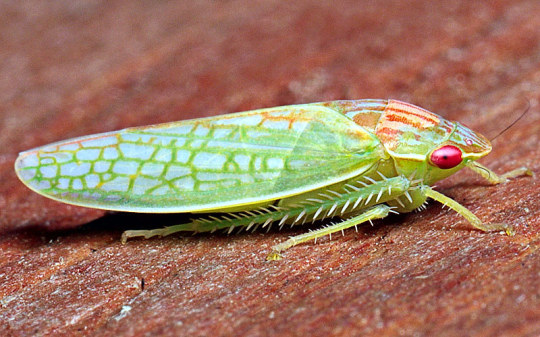
eight-lined leafhopper, gyponana octolineata
photo credit
2 notes
·
View notes
Photo



[7/30/20] Leafhopper, Subgenus Gyponana.
just a normal leaf move along
#leafhopper#leafhoppers#insect#insects#outdesign posts things#outdesign attempts to photo#insect catalog
54 notes
·
View notes
Photo

Leafhopper Nymph (Gyponana) on the Lynn Valley Trail, June 2018. This Leafhopper isn't fully Adult because it hasn't developed wings yet. The Genus Gyponana contains many species, some of which lay their eggs inside of woody twigs or branches. . . . . . . . #nature #ontario #leafhoppernymph #gyponana #cicadellidae #leafhoppers #insect_macro #macro_love #naturemacro #beautifulbugs #ontariobugs #ontarionaturephotography #lynnvalleytrail #blognorfolk #norfolkwild #gonorfolk (at Lynn Valley Trail) https://www.instagram.com/p/CQNyWoLgY2d/?utm_medium=tumblr
#nature#ontario#leafhoppernymph#gyponana#cicadellidae#leafhoppers#insect_macro#macro_love#naturemacro#beautifulbugs#ontariobugs#ontarionaturephotography#lynnvalleytrail#blognorfolk#norfolkwild#gonorfolk
1 note
·
View note
Photo


Gyponana sp. “Common Green Leafhopper” Cicadellidae
Seeley Lake, MT September 13, 2014 Robert Niese
These leafhoppers are extremely abundant in North America but are next to impossible to identify beyond genus using external characteristics alone. These species tend to feed on the sap of conifers, and considering that this little guy was found in one of Montana’s most famous larch forests, I’m gonna guess he’s a larch specialist.
#Gyponana#leafhopper#Cicadellidae#Hemiptera#true bugs#Seeley Lake#Montana#Pacific Northwest#natural history#original photography#photographers on tumblr#macro photography#Robert Niese
23 notes
·
View notes
Photo

280 days of Urbpandemonium #156 Most leafhoppers are tiny inconspicuous things, green or brown flecks living among the foliage. This Gyponana* is a comparative giant, at nearly a half inch, measured against the screen door grid. * this is another one for the hive mind. Nana seems to mean small, I can't find any reason for gypo. There is another genus called ponana in the same subfamily--probably one derived from the other. There needs to be a field of taxonomic historic etymology to untangle all this.
1 note
·
View note
Text

figured out how to make my new camera do the thing :}
get ready to look at even more bugs
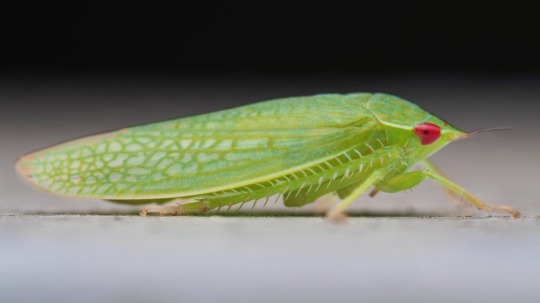
(Cyrtoxipha columbiana, Gyponana sp.)
623 notes
·
View notes
Photo

Bug of the Day
The season is winding down, but one good thing about it being cooler outside is that this leafhopper stayed still for a photo. I know this is genus Gyponana but having a lot of trouble narrowing it down to species...
108 notes
·
View notes
Photo

bug of the day on Flickr.
Found this wacky-colored pink leafhopper by the black light last month. Apparently there are a few species in this genus, Gyponana, where the coloration of individuals run the gamut from green to pink. This is either G. octolineata or G. gladia. Looks like someone with a tie-dye kit got a hold of it :-).
55 notes
·
View notes